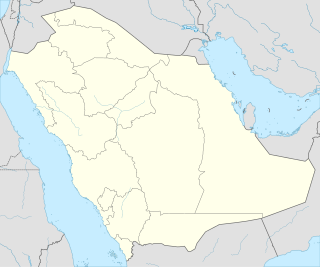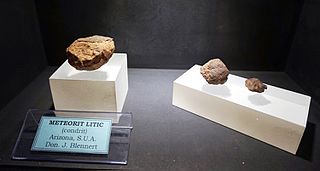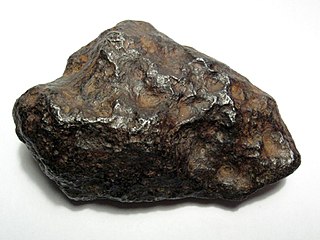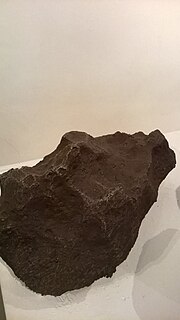
A meteorite is a solid piece of debris from an object, such as a comet, asteroid, or meteoroid, that originates in outer space and survives its passage through the atmosphere to reach the surface of a planet or moon. When the original object enters the atmosphere, various factors such as friction, pressure, and chemical interactions with the atmospheric gases cause it to heat up and radiate energy. It then becomes a meteor and forms a fireball, also known as a shooting star or falling star; astronomers call the brightest examples "bolides". Once it settles on the larger body's surface, the meteor becomes a meteorite. Meteorites vary greatly in size. For geologists, a bolide is a meteorite large enough to create an impact crater.

Meteor Crater is a meteorite impact crater about 37 mi (60 km) east of Flagstaff and 18 mi (29 km) west of Winslow in the northern Arizona desert of the United States. The site had several earlier names, and fragments of the meteorite are officially called the Canyon Diablo Meteorite, after the adjacent Cañon Diablo. Because the United States Board on Geographic Names recognizes names of natural features derived from the nearest post office, the feature acquired the name of "Meteor Crater" from the nearby post office named Meteor.

The Wabar craters are impact craters located in Saudi Arabia first brought to the attention of Western scholars by British Arabist, explorer, writer and Colonial Office intelligence officer St John Philby, who discovered them while searching for the legendary city of Ubar in Arabia's Rub' al Khali in 1932.

In meteoritics, a meteorite classification system attempts to group similar meteorites and allows scientists to communicate with a standardized terminology when discussing them. Meteorites are classified according to a variety of characteristics, especially mineralogical, petrological, chemical, and isotopic properties.

Boxhole is a young impact crater located approximately 180 km north-east of Alice Springs in the Northern Territory, Australia. It is 170 metres in diameter and its age is estimated to be 5,400 ± 1,500 years based on the cosmogenic 14C terrestrial age of the meteorite, placing it in the Holocene. The crater is exposed to the surface.

Campo del Cielo refers to a group of iron meteorites and to the area in Argentina where they were found. The site straddles the provinces of Chaco and Santiago del Estero, 1,000 kilometers (620 mi) north-northwest of Buenos Aires, Argentina. It is half that distance, north-east, to Paraguay's capital, Asunción. The crater field covers 3 by 18.5 kilometres and contains at least 26 craters, the largest being 115 by 91 metres.

The Canyon Diablo meteorite refers to the many fragments of the asteroid that created Meteor Crater, Arizona, United States. Meteorites have been found around the crater rim, and are named for nearby Canyon Diablo, which lies about three to four miles west of the crater.

The Cape York meteorite, also known as the Innaanganeq meteorite, is one of the largest known iron meteorites, classified as a medium octahedrite in chemical group IIIAB. In addition to many small fragments, at least eight large fragments with a total mass of 58 tons have been recovered, the largest weighing 31 tonnes. The meteorite is loosely named after the location where the largest fragment was found: 23 miles (37 km) east of Cape York, in Savissivik, Meteorite Island, Greenland.

Meteoric iron, sometimes meteoritic iron, is a native metal and early-universe protoplanetary-disk remnant found in meteorites and made from the elements iron and nickel mainly in the form of the mineral phases kamacite and taenite. Meteoric iron makes up the bulk of iron meteorites but is also found in other meteorites. Apart from minor amounts of telluric iron, meteoric iron is the only naturally occurring native metal of the element iron on the Earth's surface.

Iron meteorites, also known as siderites, or ferrous meteorites, are a type of meteorites that consist overwhelmingly of an iron–nickel alloy known as meteoric iron that usually consists of two mineral phases: kamacite and taenite. Most iron meteorites originate from cores of planetesimals, with the exception of the IIE iron meteorite group

Mesosiderites are a class of stony–iron meteorites consisting of about equal parts of metallic nickel-iron and silicate. They are breccias with an irregular texture; silicates and metal occur often in lumps or pebbles as well as in fine-grained intergrowths. The silicate part contains olivine, pyroxenes, and Ca-rich feldspar and is similar in composition to eucrites and diogenites.

Mbozi is an ungrouped iron meteorite found in Tanzania. It is one of the world's largest meteorites, variously estimated as the fourth-largest to the eighth-largest, it is located near the city of Mbeya in Tanzania's southern highlands. The meteorite is 3 metres (9.8 ft) long, 1 metre high, and weighs an estimated 16 metric tons.

Neuschwanstein was an enstatite chondrite meteorite that fell to Earth on 6 April 2002 at 22:20:18 GMT near Neuschwanstein Castle, Bavaria, at the Germany–Austria border.

The Chinga meteorite is an iron meteorite. It is structurally an ataxite with very rare kamacite lamella. The meteoric iron is a part of the lamella taenite. The total chemical composition is 82.8% iron, 16.6% nickel, and the rest mostly cobalt and phosphorus.

The Dronino meteorite is a 40-kilogram (88 lb) iron meteorite that was found in the Ryazan Oblast of Russia in July 2000. It is classified as an ataxite.

The Nantan meteorite is an iron meteorite that belongs to the IAB group and the MG subgroup.

The Zakłodzie meteorite is a stony-iron meteorite found in Poland in 1998. Its mass is 8.68 kilograms (19.1 lb). It is composed predominantly from enstatite and meteoric iron. Currently classified as an ungrouped enstatite achondrite its classification is still an ongoing scientific debate.
IIG meteorites are a group of iron meteorites. The group currently has six members. They are hexahedrites with large amounts of schreibersite. The meteoric iron is composed of kamacite.
The Bellsbank meteorite is a hexahedrite iron meteorite with abundant schreibersite. It is classified as a member of the IIG group. It was found in Bellsbank, South Africa in 1955.

IIAB meteorites are a group of iron meteorites. Their structural classification ranges from hexahedrites to octahedrites. IIABs have the lowest concentration of nickel of all iron meteorite groups. Most iron meteorites are derived from the metallic planetary cores of their respective parent bodies, but in the case of the IIABs the metallic magma separated to form not only this meteorite group but also the IIG group.


















